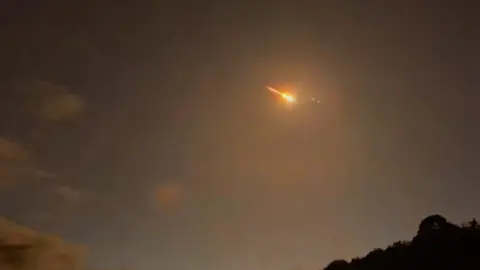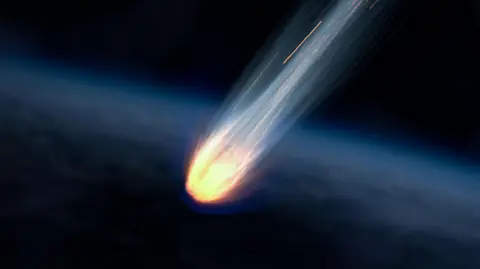Meteor pieces may have landed on Ben Nevis, say experts
 Getty Images
Getty ImagesExperts believe pieces of a small meteor that lit up the night sky over parts of the UK on Thursday have landed on and around Ben Nevis.
Dozens of people in the west Highlands reported an orange glow and a "bang", and the meteor was captured streaking across the sky on doorbell security cameras.
UK Meteor Network (UKMON), which played a part finding Gloucestershire's Winchcombe meteorite in 2021, said the small meteor had travelled from between Mars and Jupiter.
UKMON said it was observed descending to about 12 miles (20km) above the ground and pieces could be scattered across a vast area between lochs Treig and Etricht.
The network, which started in 2012, involves more than 200 amateur astronomers.
The group uses observations, captured footage and computer programs to calculate orbits and trajectories to figure out the location of meteorites.
Meteorite is the term for a piece of meteor that hits the ground, after it survives coming through the atmosphere.
The sightings of the small meteor were made after midnight.
UKMON said potential locations for the meteorites could be around Ben Nevis - the UK's highest mountain.
Toni Hanlon told BBC Scotland News she felt her house in nearby Fort William shake.
She added: "My husband and kids slept through it though."
 Ray Whyte
Ray WhyteRay Whyte was staying in a static caravan with his dog Rocky while working in Glen Nevis near Ben Nevis when he was startled by the meteor.
He said: "I couldn't sleep after a hard day so got up for a coffee.
"Me and the dog jumped out our skin with the bang.
"I missed the light as the curtains were drawn, but the whole static shook like it had been used as a drum or a vehicle had hit the side.
"Left us both pretty scared and confused."
 @adriancoll1
@adriancoll1UKMON said the meteor was travelling at about 12,427mph (20,000kmh) when it entered Earth's atmosphere.
It was seen burning as brightly as a full moon before "going dark".
Wind and other weather data, as well as any information gathered by the UK Fireball Alliance, is used to help work out where meteorites land.
UKMON has appealed to hillwalkers to keep a lookout for pieces of meteorite and has advice on its website on how to identify the space rock.
But the organisation said finding meteorites would be difficult in a vast area of mountains and glens.
The Winchcombe meteorite was the first to be found on UK soil for 30 years.
Experts said the rock travelled for millions of years before reaching Earth.
What to do if you find a meteorite?
 Getty Images
Getty ImagesA meteorite will typically resemble a charcoal briquette and have a very dark black or brown colour and a smooth, rounded surface.
It will usually have a glossy crust, which may have broken away in places, and sometimes the interior will be lighter in colour.
The UK Fireball Alliance (UKFAII) has published a guide of what to do if you find one.
You should take photos of the rock, ideally with a ruler in the photo, and avoid touching it with bare hands.
Use Google maps to document the location - longitude and latitude.
Place it in a clean, dry sandwich bag or tin foil, ideally using clean tongs.
Close and seal the bag and place this in another sandwich bag to keep it dry. Report the sample to the UK Fireball Alliance.
